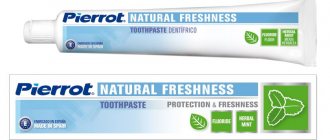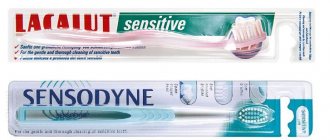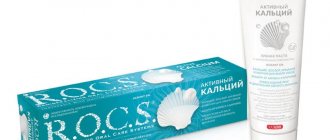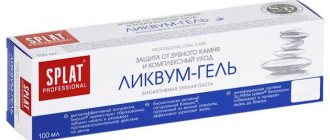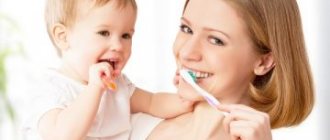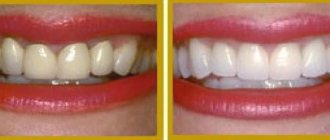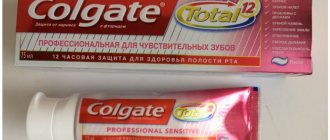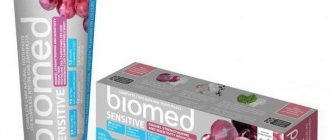No dentist will give a definite answer to the question of which toothpaste you should choose for regular teeth cleaning.
The huge range of toothpastes on the modern market leaves the right of choice to the patient, since the effectiveness of the paste can only be determined after personal experience of using it.
The doctor can only explain which series of products should be used to brush teeth in a particular situation, based on the patient’s oral problems.
Properties of toothpastes
A good toothpaste should have certain properties, namely:
- have a pleasant taste and smell;
- produce a high refreshing effect;
- prevent the formation of plaque on teeth;
- be homogeneous;
- do not dry out or delaminate during storage;
- have an anti-caries effect;
- do not cause allergic reactions, be harmless to the body;
- correspond to the effect stated on the label after use;
- For complete teeth cleaning, a strip of paste 0.5-1 cm long should be enough.
To choose the right toothpaste, you need to carefully study its purpose and composition, since different products are used for different problems of the oral cavity.
Why do we need dental floss?
Even the most advanced and multifunctional toothbrush is not able to clean out all the plaque and food debris from the area between the teeth. The bristles can enter the interdental space, but cannot fully clean it. As a result, caries forms in this inaccessible area, which is not easy to notice and therefore difficult to cure. Hidden caries is a serious problem and often leads to pulpitis.
However, there is a hygiene product that solves the problem of hidden caries - dental floss .
When used daily, floss reduces the risk of developing caries on interdental surfaces to zero. Dentists recommend flossing after every brushing, but this can be difficult in today's fast-paced lifestyle. Therefore, flossing every night after brushing your teeth is a great option.
A huge number of different flosses have been created: thin and voluminous, waxed (coated with special wax) and unwaxed. There are superflosses - threads with a voluminous middle part and thin tips. They are designed for cleaning teeth with braces, around implants and crowns, but are also convenient for cleaning teeth without any structures.
Our doctors recommend the following dental floss: fine Oral-B Satin floss, bulky Splat Dentalfloss with bergamot and lime, or Lacalut Dentalfloss .
Dental floss
What types of toothpastes are there?
Based on their effect on the oral cavity, pastes are divided into therapeutic, therapeutic and prophylactic and prophylactic. Belonging to one or another group is indicated on the front side of the package, so determining the purpose of the paste at the time of purchase is not difficult.
Depending on the age orientation, pastes are divided into children's and adults. Children's products for small children have a special composition, since there are often cases of them being swallowed by children during cleaning, and the components of adult pastes are prohibited here. Manufacturers add the same substances to toothpastes for older children as to adult products, but in lower concentrations.
List of the best hygiene products for cleaning braces
After installing braces, oral hygiene becomes too difficult. Metal elements interfere with high-quality surface treatment. Plaque accumulates in areas directly adjacent to the braces and tartar forms.
For cleaning you have to use special brushes and brushes. At the same time, increased demands are placed on cleaning compositions. They must carefully remove dirt, but not damage the enamel and elements of the bracket system.
- Dentaid Vitis Orthodontic
- Pierrot Natural Freshness
- ROCS Pro Brackets & Ortho
- Professor Persin
- Biorepair Junior
Composition of toothpastes
There are standard components that are included in any paste, regardless of its purpose:
- Abrasives are chalk additives, silicon and calcium compounds. Abrasive components are responsible for the quality of cleansing enamel from plaque.
- Water, glycerin - maintain moisture and consistency of the paste.
- Xanthan gum is a stabilizer and thickener, also responsible for the consistency of the product.
- Foaming substances - depending on their amount, the paste foams more or less while brushing your teeth.
- Sorbitol or xylitol – give the paste a sweet taste. Sorbitol also serves as an emulsifier, and xylitol inhibits the development of cariogenic bacteria.
- Preservatives (sodium benzoate, parabens) – prevent the development of bacteria in an open tube, extend the shelf life of the paste. Should be used in limited quantities in products for children.
- Flavorings – peppermint oil is most often used.
Undesirable components that should be excluded from the composition, or their quantity should be reduced to a minimum, include:
- Polyethylene glycol (PEG) is harmful to the kidneys.
- Sodium lauryl sulfate - in large quantities has a negative effect on the mucous membranes of the mouth and stomach.
- Triclosan, chlorhexidine - have an antibacterial effect and are allowed only for medicinal pastes. With prolonged daily use of products containing these substances, the vital activity of the normal microflora of the oral cavity is disrupted.
Rating of the best hypoallergenic hygiene products
The formulations of modern products are powerful. It is ensured due to the presence of potent components in the composition. Many of them fall into the category of allergens: strontium citrates and nitrates, parabens, triclosan, potassium pyrophosphate, etc.
To avoid irritation and other negative reactions, you need to eliminate potentially harmful substances as much as possible. Using natural ones instead: pectin, menthol, aminofluoride, silicon dioxide, etc.
- Weleda “With calendula”
- ROCS baby
- Splat Zero Balance
- Faberlic “Astronautik”
- Vilsen DENTALUX
Preventative toothpastes
Preventive toothpastes are also called hygienic; their purpose is daily oral care without therapeutic effects. They are used to cleanse and refresh the oral cavity, if there are no complaints about the condition of the teeth and gums.
The main components of these pastes are: chemically precipitated chalk, glycerin, water, flavorings, preservatives and thickeners. Fluoride and calcium are sometimes added to prophylactic products to prevent the development of caries.
Therapeutic and prophylactic agents This is the most extensive group of toothpastes; it is divided into several subgroups.
The best hygiene products for gum restoration
Periodontal damage can be of different types: mechanical, bacterial, hereditary, etc. They are accompanied by bleeding, inflammation of the mucous membrane, and increased sensitivity.
Hygienic products must have wound-healing, antibacterial and nutritional properties, relieve itching and prevent the formation of tartar. In some cases, antibacterial components are included in the active formula to suppress pathogenic microflora.
- Forest balm
- Parodontol Active
- ROCS Bionica
- Splat "Lavandasept"
- PresiDENT Exclusive
Fluoride-containing pastes
Such pastes are enriched with fluoride in the form of sodium fluoride, aminofluoride or monofluorophosphate in various concentrations. The designation of fluoride concentration on the packaging can be seen as the abbreviation “ppm” (parts per million). For adults, this value should not be higher than 1500 ppm. Fluoride-containing toothpaste should not be swallowed, so it should not be used on children who cannot spit and rinse their mouths.
Fluoride is effective in preventing the development of caries, but it should only be used in areas where low fluoride levels in the water have been confirmed. Residents of areas with sufficient fluoride levels should not use fluoride toothpastes. If you neglect this rule, due to an excess of the element in the body, dental fluorosis will develop - a violation of the pigmentation and structure of tooth enamel.
Main components
Abrasives are responsible for removing plaque, otherwise known as cleaning or polishing agents. These include baking soda, silicon compounds, calcium carbonate or calcium phosphate. More expensive toothpastes contain a substance called hydrating silica, which is a better alternative to baking soda or calcium phosphate.
The abrasiveness of toothpastes is determined using the abrasiveness index. On the packaging it is marked with the abbreviation RDA (Relative Dentin Abrasivity). This indicator was invented by the American Dental Association. RDA determines the ability of a paste to disrupt the structure of tooth enamel and produce mechanical effects (enamel abrasion). It is believed that effective plaque removal is achieved with RDA values just above 100. Regular toothpaste consists of half abrasive components. If it contains more than 50% polishing agents, it can cause tooth sensitivity.
Almost any toothpaste contains foaming agents that save consumption and help fight plaque. However, large amounts of such substances cause irritation and redness in the mouth.
Flavorings and flavoring additives are added to the paste. Also, for normal consistency, toothpastes need binders (also called hydrocalloids) - components that help retain moisture so that bacteria do not grow in the paste, and preservatives.
Without all these components, toothpaste will not work. However, often instead of harmless natural flavors, abrasives and preservatives, chemists use harmful and life-threatening substances.
Remineralizing pastes
The products are designed to strengthen the enamel by saturating it with calcium and phosphorus compounds. Typically, pastes contain calcium citrate and calcium glycerophosphate. To get the proper effect, you need to brush your teeth for at least three minutes.
In addition to toothpastes, remineralizing gels are used at home: they are applied to the teeth and left for the time specified in the instructions for the product.
The use of remineralizing agents is especially indicated for children from 6 years of age, during adolescence, when permanent teeth appear, intensive skeletal growth occurs and the need for calcium increases. Pastes are also recommended for pregnant women, as their tooth enamel often suffers from a lack of calcium.
Organic products
Organic toothpastes are available for all ages. You can purchase the product for both children and adults. They contain only natural ingredients. According to user reviews, these products are able to cope with their functions just as effectively as their synthetic counterparts. Such products are absolutely safe for people of all ages. On sale you can find organic pastes based on medicinal plants. They relieve inflammation well, help speed up the healing process of wounds and are excellent at fighting bleeding gums.
Pastes with whitening effect
Many manufacturers of whitening toothpastes are disingenuous when they call them whitening; it would be more correct to call them “brightening” or “with an increased cleansing effect.” Lightening of enamel in pastes occurs by removing plaque and returning the natural color to the teeth. True enamel whitening can only be done in the dentist's office.
Removal of plaque using this group of products occurs due to increased abrasiveness; a tube of paste with a truly cleansing effect should contain information about the abrasiveness index. It is designated by the letters RDA; the higher the digital value of the index, the larger the grinding particles. RDA index values:
- 30-50 – non-abrasive paste, suitable for cleaning sensitive teeth;
- 50-80 – low abrasive, can be used by children over 14 years of age;
- 80-100 – moderately abrasive, used by adults daily;
- 100-200 – high abrasiveness of the paste, teeth are brushed 1-2 times a week, sometimes less often; It is advisable to consult a dentist before use.
The recommended abrasiveness for daily use is RDA 70-80, but you need to focus on the condition of your teeth and gums.
There are pastes in which the enamel is cleansed not through abrasive particles, but through the action of the enzymes papain and bromelain. Enzymes enter into a chemical reaction with plaque, gradually dissolving it.
If the packaging of a whitening toothpaste does not contain information about the RDA index or does not contain enzymes, it is unlikely that this product will be able to lighten tooth enamel.
Just what the doctor ordered
The stereotype “quality is expensive” in many cases reflects reality. But while the average consumer can evaluate the quality of shoes, clothing or food products himself, in the case of toothpaste this is almost impossible. It is clear that high-quality food is tasty, high-quality clothes are well-made and fit well. What should a high-quality pasta be like? Delicious? Interesting looking? With a pleasant smell? This is all important, of course, but the main purpose of the paste is to clean your teeth. How can you evaluate the quality of teeth cleaning without the help of a specialist?
“The dentist should recommend toothpaste,” Eleonora Sakharova is sure. “He can say: you have sensitive enamel, you need a toothpaste with potassium salts. And you go to the pharmacy, and you have a choice: if you like gels, choose gel, if you like mint paste, choose mint, if you like it with stripes, choose with stripes. But you know for sure that not only do you like it, but it also meets the needs of your teeth specifically. And it’s great that we as consumers have the opportunity to choose according to our preferences and financial capabilities.”
In the struggle for consumers, manufacturers of many pastes claim that their paste is the best at preventing caries and dental diseases. And for the most part this is indeed true. “Any paste that contains fluorides, anti-inflammatory and cleansing elements is a powerful tool for the prevention of diseases of the teeth and gums,” says Eleonora Sakharova. “Pastes, of course, cannot cure existing caries, but if a person brushes his teeth regularly and correctly, a healthy lifestyle and undergoes preventive examinations twice a year, he will not have problems with his teeth. And pasta is our main assistant in this.”
However, according to dentists themselves, no more than a quarter of Muscovites regularly visit a doctor for preventive care (in the regions this figure is even lower). This means that the rest are still guided by other considerations. In addition, several years ago, British scientists from the University of Newcastle conducted a study that, although it was widely disseminated, fortunately for toothpaste manufacturers, was perceived by consumers rather as a joke. As a result of experiments on twelve volunteers, scientists concluded that if you do not brush your teeth at all, they will deteriorate, but if you brush too intensely and often, they may fall out.
STANISLAV KRYLOV
Products for sensitive teeth
Pastes for sensitive teeth contain strontium chloride, potassium nitrate and sodium citrate - substances that block the sensitivity of nerve endings. A common component is hydroxyapatite; it is capable of creating a protective film on enamel. The pastes also contain extracts and oils of medicinal herbs, which have a beneficial effect on the condition of the gums.
Decreased tooth sensitivity develops a few days after starting to use the medicinal paste. But such products cannot be used for too long due to the fact that they do not have sufficient abrasiveness and do not remove plaque well. In addition, a constant decrease in tooth sensitivity leads to masking the symptoms of other diseases, such as caries.
At first, soft toothbrushes are used with toothpaste for sensitive teeth, but as soon as the painful sensations disappear, you need to return to a regular brush with medium bristles (medium hardness). If this is not done, plaque will begin to accumulate on the enamel.
After a treatment course with toothpaste for sensitive teeth, they switch to using remineralizing pastes.
The best whitening products
Their action is based on the use of powerful abrasive and non-abrasive components. Abrasives have a coarse structure and are capable of removing even tartar. You need to be careful when choosing. Strong drugs may damage the surface. Non-abrasive compounds are gentle on hard tissues. But they cannot boast of whitening several shades.
- Lacalut White
- President White plus
- Splat "Whitening plus"
- Silca arctic white
- Rocs PRO “Delicate whitening”
Products for smokers should perfectly whiten specific pigment stains.
- Rembrandt “Antitobacco and coffee”
- Dentavit “For smokers”
- ROCS "Antitobacco"
- Zact "For smokers"
- White Glo
